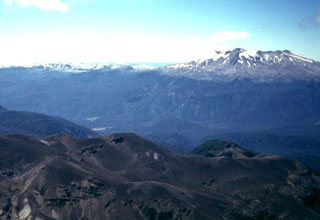Report on Puyehue-Cordon Caulle (Chile) — 20 July-26 July 2011
Smithsonian Institution / US Geological Survey
Weekly Volcanic Activity Report, 20 July-26 July 2011
Managing Editor: Sally Sennert.
Please cite this report as:
Global Volcanism Program, 2011. Report on Puyehue-Cordon Caulle (Chile) (Sennert, S, ed.). Weekly Volcanic Activity Report, 20 July-26 July 2011. Smithsonian Institution and US Geological Survey.
Puyehue-Cordon Caulle
Chile
40.59°S, 72.117°W; summit elev. 2236 m
All times are local (unless otherwise noted)
OVDAS-SERNAGEOMIN reported that on 20 July cameras installed around the Puyehue-Cordón Caulle volcanic complex recorded gray ash plumes that rose 3 km above the Cordón Caulle rift zone. Satellite imagery showed that the plume drifted 80 km E, becoming diffuse. Incandescence up to 500 m above the crater was observed at night. During 20-21 July seismic signals indicated active lava flows. Cloudy weather on 21 July prevented crater observations. Eruption plumes observed in satellite imagery on 22 July drifted 250 km E and SE. Seismic data indicated that the lava flows had stopped. The next day plumes rose 1-2 km above the crater; satellite imagery detected plumes that drifted 100 km E and SE. On 25 July gray ash plumes rose as high as 2.5 km and drifted SE. Lava flows were again active based on seismic data. The Alert Level remained at Red.
Geological Summary. The Puyehue-Cordón Caulle volcanic complex (PCCVC) is a large NW-SE-trending late-Pleistocene to Holocene basaltic-to-rhyolitic transverse volcanic chain SE of Lago Ranco. The 1799-m-high Pleistocene Cordillera Nevada caldera lies at the NW end, separated from Puyehue stratovolcano at the SE end by the Cordón Caulle fissure complex. The Pleistocene Mencheca volcano with Holocene flank cones lies NE of Puyehue. The basaltic-to-rhyolitic Puyehue volcano is the most geochemically diverse of the PCCVC. The flat-topped, 2236-m-high volcano was constructed above a 5-km-wide caldera and is capped by a 2.4-km-wide Holocene summit caldera. Lava flows and domes of mostly rhyolitic composition are found on the E flank. Historical eruptions originally attributed to Puyehue, including major eruptions in 1921-22 and 1960, are now known to be from the Cordón Caulle rift zone. The Cordón Caulle geothermal area, occupying a 6 x 13 km wide volcano-tectonic depression, is the largest active geothermal area of the southern Andes volcanic zone.
Source: Servicio Nacional de Geología y Minería (SERNAGEOMIN)

